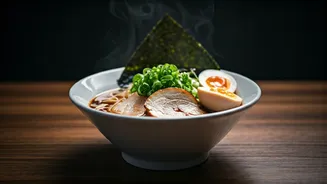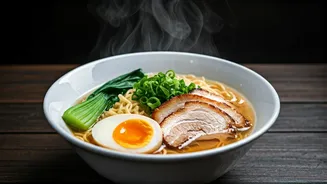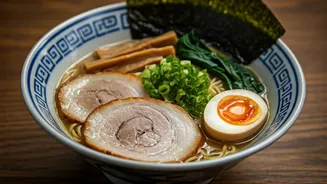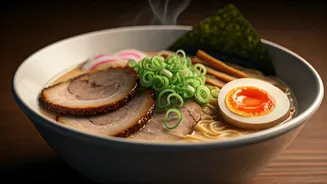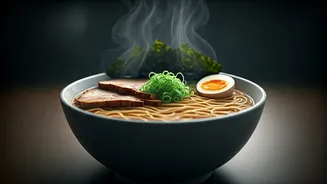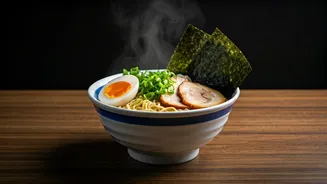Ramen's Humble Beginnings
Ramen's story, a dish embraced worldwide, began in China and traveled to Japan. It wasn't always the complex dish we savor today. Initially, ramen was a simple
noodle soup, a quick and inexpensive meal for workers. Over time, Japanese chefs embraced ramen, transforming it into a culinary phenomenon. They refined the broth, experimented with toppings, and perfected the noodles, leading to the diverse range of ramen styles we recognize today. This evolution reflects a fusion of cultures, a blend of culinary influences resulting in a beloved dish.
Broth: The Soul of Ramen
The broth is considered the essence of any great ramen bowl. It's where the magic truly unfolds. Different broths are carefully constructed using techniques that have been passed down for generations. The most common varieties involve simmering pork bones (tonkotsu), chicken (torigara), or a combination of both. Other broths, like shoyu (soy sauce) or miso, utilize these ingredients as their base. The process can take hours, or even days. The longer the broth simmers, the richer and more complex its flavor becomes. It's a symphony of flavors, where all of the ingredients are carefully balanced to create something delicious.
Noodles: The Heart of it
Noodles play a crucial role in the ramen experience. They are available in various shapes and sizes. The noodles' texture and thickness determine how they will absorb the broth and how you eat them. Thin, straight noodles are often paired with lighter broths, while thicker, wavy noodles are able to hold up better to richer, heavier broths. The quality of noodles is paramount. Many ramen shops make noodles in-house, ensuring freshness and consistency. The wheat flour quality and the hydration levels of the dough will affect the final product's quality.
Toppings: Flavorful Accents
Toppings are important and add color, texture, and additional flavor. Chashu pork, typically slow-braised pork belly, is a favorite, offering richness and melt-in-your-mouth goodness. Seasoned soft-boiled eggs (ajitama) bring a creamy element. Bamboo shoots (menma) contribute a crunchy texture. Other popular toppings include seaweed, scallions, fish cakes, and various vegetables like bean sprouts. The combination of toppings complements the broth and noodles, resulting in a balanced and visually appealing bowl.
Shoyu Ramen: Classic Taste
Shoyu ramen, or soy sauce ramen, is one of the oldest and most popular ramen styles. Its broth features a soy sauce base, resulting in a salty, savory flavor profile. This broth often incorporates chicken or pork bones and is combined with noodles of medium thickness. The classic toppings include chashu pork, seasoned eggs, bamboo shoots, and nori (seaweed). Shoyu ramen's simplicity and well-balanced flavors make it a favorite. Many ramen shops highlight their own unique shoyu blend.
Miso Ramen: Earthy Delight
Miso ramen brings a richer, more umami-packed experience. The broth is based on fermented soybean paste (miso), which gives it a distinct flavor. The miso adds depth and complexity to the broth, often combining chicken or pork. Miso ramen typically includes thicker, wavy noodles and generous toppings, like chashu pork, corn, and butter. There are regional variations, from Hokkaido's butter-laden style to the many different miso variations available throughout Japan. Each has its own unique flavor profile.
Tonkotsu Ramen: Creamy Bliss
Tonkotsu ramen is characterized by its rich, creamy, and milky broth, created from pork bones that are boiled for long periods. This process extracts collagen and fats, resulting in a luxurious texture. The broth has a full-bodied flavor, complemented by medium-thick noodles. The toppings frequently include chashu pork, wood ear mushrooms, and pickled ginger. This style is quite common throughout Japan. The creamy broth and flavorful toppings make tonkotsu ramen a truly unforgettable experience.
Tsukemen: Dipping Noodles
Tsukemen is a unique ramen experience where the noodles and broth are served separately. The noodles are typically cold and thicker, with a firm texture. The dipping broth is concentrated and more intensely flavored than a typical ramen broth. This enables you to control the level of broth in your mouth. You dip your noodles into the broth before eating. Tsukemen offers a different way to enjoy ramen, emphasizing the texture of the noodles and the power of the dipping broth. This allows you to experience the flavors in a concentrated way.
Customizing Your Bowl
Ramen is meant to be customized to suit personal preferences. Shops typically offer a range of options, from noodle thickness and firmness to the richness of the broth. You can often adjust the amount of oil, saltiness, and toppings. Some ramen establishments even let you customize the flavor profile. From adding a bit more spice to requesting extra toppings, ramen is a highly adaptable dish. Exploring different combinations and discovering your ideal bowl is part of the fun of enjoying ramen.


